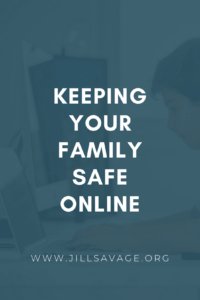This blog post may contain affiliate links. Read my disclosure policy here.

Did you know that in 2017, the world’s most popular porn website had 80 million daily visits?
Did you know 90% of teens and 96% of young adults are either encouraging, accepting, or neutral when they talk about porn with their friends?
Did you know one out of every five mobile searches is for pornography?
Did you know over 40% of regular porn users started viewing pornography between the ages of 11 and 13? (This age trends lower every year.)
Source: Covenant Eyes
Porn is a real struggle for so many. My husband has had to navigate it. My kids have had to navigate it. Mark regularly counsels men who are struggling with it. We regularly meet with couples whose marriage has been impacted by it.
And unlike it’s often portrayed, it’s not just an issue for men.
Sometimes I know it can be overwhelming to think about how to navigate it. How do you talk about it? What will really work? What tools are out there to help?
Preparing Our Kids
I was just talking to my son the other day about his own history with porn, and this was one of the most important things in his mind. He told me, “At the end of the day, we make decisions. It’s important that we educate our kids early and often about sex and what is available online so they are prepared for what they may encounter.”
Protecting Our Family
But beyond preparation, sometimes our children simply aren’t old enough or mature enough to make an informed decision. This is why protecting our family matters as well. I have found some great tools recently that I’d like to share with you.
Here are 4 ways to keep your family safe online:
1) Keep screens in common areas.
When my kids were younger, we always kept our computer in the kitchen. And that’s where it stayed.
In the mobile world we live in now, things are a little different. It’s rarer to spend as much time on a desktop computer than it used to be.
But that doesn’t change this principle.
You may consider implementing a family rule that phones don’t go behind closed doors, or that devices can only be used in certain parts of the house.
But keeping all devices in common areas is a great first step to prioritizing togetherness and conversation while removing a level of temptation and opportunity.
It’s also recommended to have kids plug their phones in outside of bedrooms (yes, that means they likely will need to have an alarm clock in their room during the school year.)
2) Utilize parental controls and filtering software on phones, tablets, and computers.
This is so important, and filtering software is something Mark and I have always had on our devices. There are some great options out there. Here are a few of my current favorites:
- Canopy — Canopy is a parental control app that blocks porn other filters miss, deters sexting (including bikini and lingerie photos when in strict mode!), helps parents manage what websites and apps their kids use, and tracks device location. It works on smartphones, tablets, and computers, and it’s compatible with iOS, Windows, and Android. It allows you to give your kids the freedom to explore the online world without fear. (Use coupon code SAVAGE20 to get 30 days free plus 20% off forever!)
- Bark — Bark is an app that proactively monitors text messages, YouTube, emails, Snapchat and 30+ different social networks for potential safety concerns, so busy parents can save time and gain peace of mind.
- Covenant Eyes — Covenant Eyes helps you overcome porn by monitoring your screen activity and sending a report to a trusted ally who holds you accountable for your online choices, while also featuring additional services like porn blocking and SafeSearch. (Get your first 30 days free with coupon code JSavage!)
3) Talk about sex and things kids may encounter online openly.
I want to remind you that great software and tools are not the end-all for this discussion. Kids are smart. Having a clear boundary and guardrail is SO helpful, but the conversations surrounding these topics are just as important to consistently empower our kids to make wise choices.
It’s important to talk openly about sex with our kids, about what they may encounter online, about pictures they may receive or be asked to send, about what someone might show them at school or a sleepover, and to answer any questions they may have.
This open relationship with our kids impacts how much they trust what we say about porn, whether or not they’ll talk to us in the future about struggles they’re having in their own relationships, and the confidence they have in understanding the effects (positive and negative) of the decisions they make.
Let them know it’s always okay for them to tell you ANYTHING, and then make sure you don’t over-react to ANYTHING! Even if you’re freaking out on the inside, don’t freak out on the outside. You need to be SAFE for them to talk to.
4) Don’t shame your family for struggling.
Finally, I want to highlight that porn is a very real struggle. It’s hard. It easily ensnares. And there’s a reason the word “addiction” is often connected to the topic.
Whether it’s you, your spouse, or your child, a struggle with porn is not an identity. We are first and foremost children of God. We bear His image. We are loved by Him. That’s what defines us. That’s our identity.
Let’s make sure this is the message we are sending our family instead of a message that builds on the shame they may already feel.
What would you add? Are there any other tools or tips you’ve found helpful?
No More Perfect Marriages Challenge

Our Marriage Crash Course (formerly known as the No More Perfect Marriages e-mail challenge) provides inspiration, encouragement and motivation directly to your inbox right when you need it most!
(You can view our privacy policy here.)











